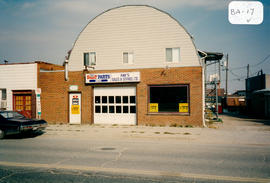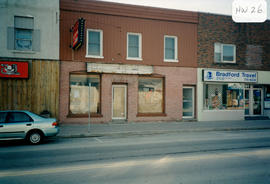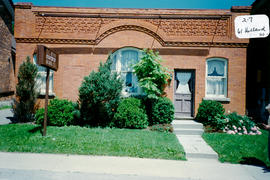17 Barrie Street Ray's Sales & Service Ltd.
- CA BWGPL GJ-HB-2017-03-07-02
- Item
- 1995
Parte de George Jackson fonds
The cement brick building (with an arch) that is located at 17 Barrie St. is not the original structure at this site. Originally, there was a large frame building (used to shelter horses, a stage coach, buggies, cutters, etc.) that was part of a livery stable owned by Dave Ogilvie many years ago. It was destroyed by fire shortly after Dave bought it and the building seen in the photo is a smaller replacement. Dave also ran a stage coach line (later a taxi service) to Newmarket to meet the Metropolitan street car. Travelling salesmen would use this stage line to bring their wares and samples to town. They would stay at the Queen’s Hotel, where they would take orders from customers. They then used the stage coach and livery to go to Middletown, Bond Head, Newton Robinson, Beeton, Cookstown, Fennell’s Corner and then back home. Dave also hauled mail from the train station to the local post office, as well as to Bond Head. When automobiles replaced horses, the stables were removed from the building and people rented storage there for their vehicles. In time, Dave added a small office, toilets and gas pumps. After he died, Gordon and Mac ran the business until it was sold to Fred Gregory. Fred ran a car repair shop and employed a mechanic. Fred had a rental apartment built upstairs. It had outside stairs to the laneway. When Fred got sick he rented the building to Ray O’Neil who later bought it. Ray sold the building to the European Bakery in 1994. (1, 2)
Sem título








